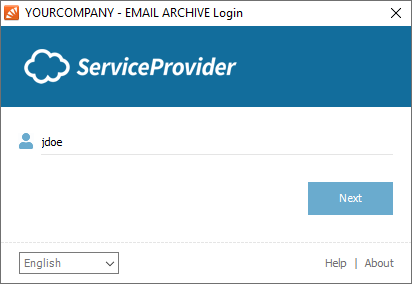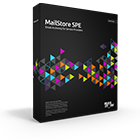Difference between revisions of "End User Access"
| [checked revision] | [checked revision] |
m (Dweuthen moved page End Customer Access to End User Access: Term "end customer" is very uncommon) |
|||
| Line 1: | Line 1: | ||
__NOTOC__ | __NOTOC__ | ||
| − | The logon process for | + | The logon process for customers to administrate their MailStore Instance or to access their archives varies slightly from the logon process of an on-premises MailStore Server. |
Find detailed information about logging in with E-mail Archive Client and E-mail Archive Add-in for Outlook below. Additionally find information about how to log on to Web Access using a web browser or the integrated IMAP server using any IMAP capable email client. | Find detailed information about logging in with E-mail Archive Client and E-mail Archive Add-in for Outlook below. Additionally find information about how to log on to Web Access using a web browser or the integrated IMAP server using any IMAP capable email client. | ||
| Line 8: | Line 8: | ||
== E-mail Archive Client == | == E-mail Archive Client == | ||
| − | + | Customers' administrators can access their own MailStore Instance with the E-mail Archive Client by using the credentials received from their service provider. End users can use the same client to archive or export email or to access their archived email. Follow the instructions below for logging on with MailStore Client: | |
* Open the E-mail Archive Client by using the link ''E-mail Archive'' on the desktop. | * Open the E-mail Archive Client by using the link ''E-mail Archive'' on the desktop. | ||
Revision as of 15:39, 16 March 2017
The logon process for customers to administrate their MailStore Instance or to access their archives varies slightly from the logon process of an on-premises MailStore Server.
Find detailed information about logging in with E-mail Archive Client and E-mail Archive Add-in for Outlook below. Additionally find information about how to log on to Web Access using a web browser or the integrated IMAP server using any IMAP capable email client.
As both applications are identical to MailStore Client and MailStore Outlook Add-in, their system requirements can be found in the MailStore Server help.
E-mail Archive Client
Customers' administrators can access their own MailStore Instance with the E-mail Archive Client by using the credentials received from their service provider. End users can use the same client to archive or export email or to access their archived email. Follow the instructions below for logging on with MailStore Client:
- Open the E-mail Archive Client by using the link E-mail Archive on the desktop.
- Select the preferred language from the Language drop down list and enter the URL to connect to in the Server Name field. The URL must be in the format https://<ip_or_hostname_of_cas>/<instance_id_or_alias>.
- Hint: The language and server name can be saved to skip this step in the future by activating the Always connect to this server option. To change the settings again, start MailStore Client while keeping the SHIFT-key pressed.
- Click OK to connect.
- E-mail Archive Client will update itself to become compatible with the provider's version of MailStore Service Provider Edition if necessary.
- Enter your username and password.
- Click OK to log on.
E-mail Archive Add-in for Outlook
- Open Microsoft Outlook.
- If the E-mail Archive Add-in for Outlook is not pre-configured, you will be asked to log in to your MailStore Instance as soon as you click any button of the E-mail Archive Add-in for Outlook.
- Enter the URL to connect to in the Server Name field. The URL must be in the format https://<ip_or_hostname_of_cas>/<instance_id_or_alias>.
- Enter your username and password.
- Click OK to log on.
Web Access
End users can access their archived email easily via any supported web browser, by following the instructions below.
- Open a web browser.
- Navigate to Web Access. The URL is https://<ip_or_hostname_of_cas>/<instance_id_or_alias>
- Enter your username and password.
- Click Log on.
Mobile Web Access
End users can access their archived email easily via browser on a mobile device, by following the instructions below.
- Open a web browser on the mobile device.
- Navigate to Mobile Web Access. The URL is https://<ip_or_hostname_of_cas>/<instance_id_or_alias>/web/m
- Enter your username and password.
- Click Log on.
IMAP Client
Archived emails can be accessed via an integrated IMAP server with any IMAP capable email client using the following settings:
- Incoming Mail Server - Host name or IP address of a Client Access Server
- Port - For unencrypted or TLS-encrypted connections standard IMAP port 143 is used. For SSL-encrypted connections standard IMAP port 993 is used.
- User Name - Name of the MailStore user prepended by his instance id or alias <instance_id_or_alias>/<username>, e.g. jdcorp/jon.doe.
- Password - Password which is required for accessing the MailStore server.
Please note: In addition to configuring the incoming mail server, email clients often require configuring the outgoing mail server as well. In this case, using the same data as for an existing email account will facilitate further processing emails from the email archive.


